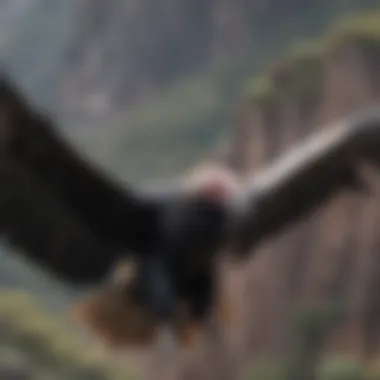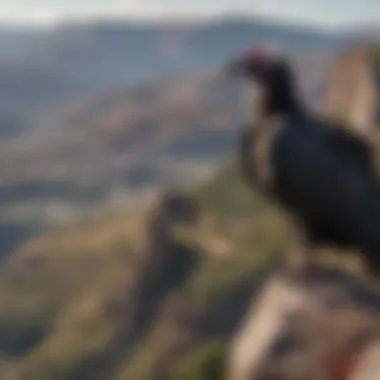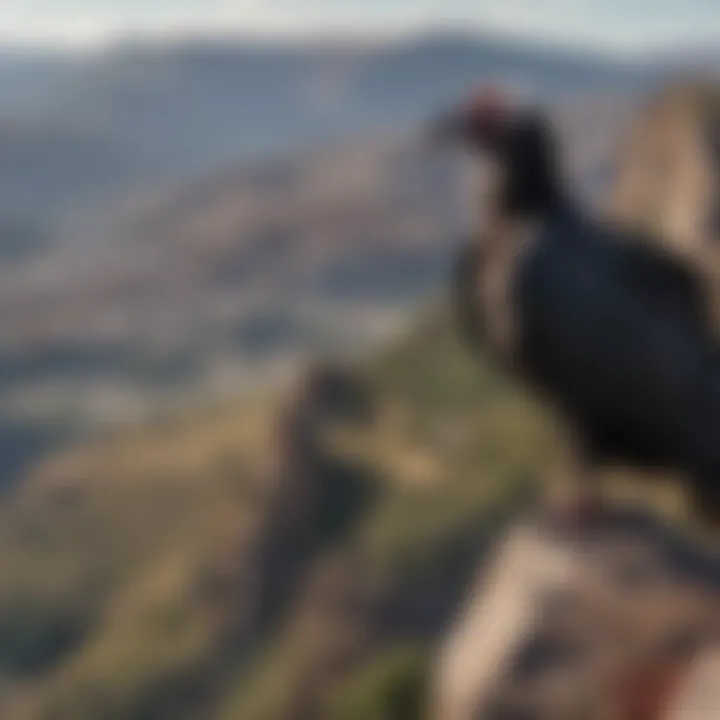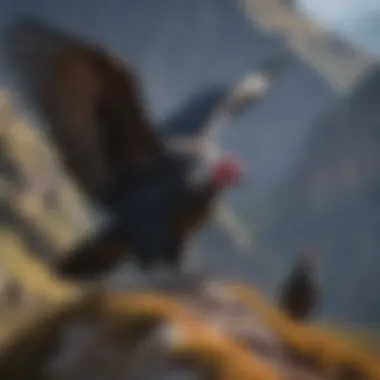The Andean Condor: Nature's Largest Bird of Prey


Intro
In a world filled with astonishing wildlife, the Andean condor reigns supreme as the largest bird of prey. With a wingspan that can stretch up to 3.2 meters, this magnificent creature soars through the skies of South America, embodying grace and strength. But what lies beneath its impressive exterior? This section not only gazes into its physical attributes but also navigates through its habitat, dietary habits, and the various roles it plays in its ecosystem.
The Andean condor is more than just its size. Its presence in the skies and on the cliffs of the Andes represents a vibrant part of the cultural tapestry of indigenous communities. Here, the condor is celebrated, feared, and respected, often seen as a symbol of power and freedom. But pressures from modern life and ecological changes pose threats to its survival, making it imperative that we understand this majestic bird more deeply.
Engaged in this exploration, one can also appreciate the significant conservation efforts taken to protect the Andean condor. Understanding these aspects is crucial not just for bird enthusiasts but for anyone who cares about the intricate web of life that sustains us all.
Intro to Birds of Prey
Birds of prey hold a remarkable position in the avian world, not just due to their impressive size and power, but also from their roles in various ecological systems. Understanding these birds offers critical insights into biodiversity, conservation efforts, and the health of our environment. This section serves as a foundation, guiding you through the core characteristics that define these fascinating creatures.
The term "birds of prey" typically refers to a group of raptors, characterized by their keen eyesight, powerful beaks, and strong talons. Engaging with this topic allows pet bird owners, aspiring bird parents, and bird breeders to appreciate the essential physiological and behavioral attributes that these birds exhibit. Through exploring their lifestyles, individuals gain better knowledge about the needs of birds in both wild and domestic settings.
As you read further, you'll discover that the classification of these avian hunters encompasses various species, each with distinctive traits and habitats. Unearthing this aspect not only enhances appreciation but also requires an awareness of their significance within the broader ecosystem.
Defining Birds of Prey
Birds of prey, often known as raptors, are defined by several key characteristics. These birds possess acute vision, allowing them to spot potential prey from impressive heights. Their physical builds typically feature strong hooked beaks for tearing flesh and powerful talons to catch and hold prey. Among commonly recognized raptors are eagles, hawks, owls, and, of course, the subject of this article—the Andean condor.
These birds also exhibit adaptations that are finely tuned to their predatory lifestyles. For instance, many raptors have feathered nostrils which help filter out dust during flight in rough terrains. This adaptation showcases their evolution and specialization for hunting and surviving in varied environments.
Birds of prey primarily feed on small mammals, fish, or other birds, depending on their specific hunting territory. This dietary element is crucial not just for their individual survival, but also plays a vital role in controlling the populations of their prey species, thereby maintaining a balance in the ecosystem.
Classification within the Avian World
When discussing the classification of birds of prey, it's essential to recognize their place in the avian taxonomy. Generally, raptors are organized into different families within the order Accipitriformes. The most notable families include:
- Accipitridae: This family encompasses many eagles and hawks, known for their formidable hunting skills and adaptability in various habitats.
- Falconidae: Falcons are distinguished by their speed and agile flight. They have a slightly different hunting strategy, often chasing down their prey in mid-air.
- Strigiformes: This group includes owls, often recognized for their nocturnal habits and silent flight.
- Cathartidae: Vultures belong to this family, playing the crucial role of scavengers in many ecosystems.
Each family showcases varying traits and hunting techniques, further emphasizing the diverse adaptations of birds of prey in response to their environments. Understanding these classifications is beneficial for recognizing how differences in anatomy and behavior can influence their roles in respective habitats.
Thus, as we unfold the story of the Andean condor later, you'll see how it fits into this vast and complex avian picture.
Characteristics of Birds of Prey
Understanding the characteristics of birds of prey is essential in appreciating their role in the ecosystem, as well as their unique adaptations that make them formidable hunters. These traits not only define their way of life but also offer insights into their survival strategies. Each bird of prey, including the magnificent Andean condor, showcases distinct physical and behavioral characteristics that enhance their predatory skills. By examining these elements, we can better appreciate these majestic creatures and advocate for their conservation.
Physical Attributes
Physical attributes of birds of prey are often what first capture the attention of observers. These birds are typically known for their impressive size and striking features. The Andean condor, for instance, features a wingspan that can extend over ten feet, making it one of the largest flying birds in the world. Their powerful, broad wings allow them to soar effortlessly in the thermals, maximizing energy efficiency while searching vast areas for food.
In addition to size, other notable features include:
- Talons and Beaks: The sharp, curved talons of raptors, including the Andean condor, are designed for grasping and tearing flesh. Their beaks are robust, often hooked, which facilitates the ripping of prey.
- Vision: An extraordinary aspect of these birds is their keen eyesight. They can spot potential meals from miles away. For example, while gliding at high altitudes, an Andean condor can detect the movement of a grazing animal on the ground, a skill vital for their survival.
- Feathers: The plumage serves more than just an aesthetic purpose. It provides insulation, allows for silent flight, and aids in communication.
Such features make birds of prey highly adapted for their ecological niche, which differentiates them from other bird species. Their anatomy supports their predatory lifestyle, fostering an efficient hunting strategy.
Behavioral Traits
The behavioral traits of birds of prey intertwine with their physical characteristics, enhancing their predatory effectiveness. The Andean condor exhibits several fascinating behaviors that make it an extraordinary member of the avian world.
- Social Structure: While many think of birds of prey as solitary hunters, the Andean condor may often be found in groups, particularly when feeding. This social behavior can be advantageous as it allows them to locate food more efficiently and share resources.
- Hunting Strategy: Unlike some raptors that actively hunt for their meals, the Andean condor primarily relies on scavenging. They utilize their powerful eyesight to locate carcasses and often follow other predators to benefit from their kills.
- Nesting Behavior: The Andean condor is known for its impressive nesting habits, choosing high ledges and cliffs to prevent potential threats from terrestrial predators. This behavior reflects their understanding of their environment and highlights the strategic aspects of their breeding.
"Birds of prey are not merely hunters; they are key players in the balance of ecosystems. Their behaviors and adaptations directly impact the landscapes they inhabit."
In summary, the unique characteristics of birds of prey—including their striking physical attributes and remarkable behavioral traits—are fundamental in defining their ecological roles and adaptations. Understanding these elements provides bird enthusiasts and conservationists with a deeper appreciation of these extraordinary creatures.
The Andean Condor: The Largest Bird of Prey
When we talk about birds of prey, one bird that surely commands attention is the Andean condor. As the largest bird of prey, its significance goes beyond mere size; it's a creature that embodies the spirit of the Andes and holds a crucial position in its ecosystem. This section will dive deep into its scientific classification, habitat distribution, and its remarkable size, each contributing to our understanding of this majestic bird's role in nature and beyond.
Scientific Classification


The Andean condor, scientifically known as Vultur gryphus, is a member of the family Cathartidae, which includes New World vultures. Interestingly, this classification places them more closely with vultures than with eagles or hawks, despite their imposing size and predatory prowess.
Classifying the Andean condor:
- Kingdom: Animalia
- Phylum: Chordata
- Class: Aves
- Order: Cathartiformes
- Family: Cathartidae
- Genus: Vultur
- Species: Vultur gryphus
This classification sheds light on the condor's feeding habits, as it primarily scavenges rather than hunting live prey. Understanding where it fits in the avian family tree helps conserve biodiversity while appreciating its unique adaptations.
Distribution and Habitat
The Andean condor thrives in South America's majestic highlands, making its home in places like the Andes mountains. Its habitat ranges from Colombia to Argentina and can be found soaring high over the rugged peaks and deep valleys.
This bird prefers open land like mountains, grasslands, and even coastal cliffs. These areas allow the condor to use its incredible wingspan to ride thermal currents effortlessly, covering vast distances in search of food. The significance of this choice of habitat is twofold: it provides ample opportunity for scavenging and also reflects the bird’s adaptation to elevation and terrain.
- The Andean condor nests on sheer cliff faces, which offer safety from land predators.
- They often prefer areas with a stable climate, where they can glide without using too much energy.
Size and Dimensions
Size-wise, the Andean condor is a behemoth among birds. With a wingspan reaching up to 3.3 meters (over 10.8 feet), it’s no wonder they capture the attention of anyone lucky enough to spot one in flight.
In terms of weight, a typical male can weigh between 50 to 70 kg (around 110 to 154 lbs), while females are slightly smaller. The impressive size isn’t just for show; it plays a crucial role in the condor's survival.
Some dimensions to note:
- Wingspan: Up to 3.3 meters
- Body length: Averages around 1.2 meters
- Weight: Typically between 50-70 kg
Their size allows them to soar at high altitudes, often exceeding 15,000 feet. High altitude flying provides them with a wider view of their surroundings, making it easier to spot carrion.
The Andean condor is not just the largest bird of prey; it is also a symbol of freedom and majesty in the skies.
With its powerful presence and unique ecological niche, the Andean condor stands as a remarkable example of adaptation and resilience. Understanding its scientific classification, habitat preferences, and striking physical traits deepens our appreciation for this extraordinary bird.
Diet and Hunting Behavior
The diet and hunting behavior of the Andean condor serve as vital indicators of its ecological role and survival strategies. Understanding what this magnificent bird consumes not only sheds light on its preferences but also reveals how it fits within the food chain. This section will explore the feeding habits and hunting techniques that make the Andean condor a formidable and essential part of its ecosystem.
Feeding Habits
The Andean condor primarily feeds on carrion, which is the decaying flesh of dead animals. It has a keen eyesight that allows it to spot potential meals from great heights, sometimes over 10 kilometers in the air. When it comes to feeding, the condor displays a somewhat opportunistic nature, often scavenging on the remains left by larger predators such as pumas or humans. Here are some important points about its feeding habits:
- Diet Diversity: While carrion makes up the bulk of its diet, Andean condors can also consume the remains of marine mammals when available. This adaptability is crucial for survival in their vast, varied habitats.
- Feeding on Large Corpses: The size of the condor allows it to feed on large carcasses, which smaller scavengers cannot efficiently utilize. Thus, it plays a significant role in cleaning the environment by disposing of dead animals.
- Social Feeding: These birds are social feeders, often gathering in groups around a carcass. This social behavior might seem counterintuitive to survival, but it ensures that they can feed efficiently and benefit from communal vigilance against potential threats.
"The Andean condor, with its impressive wingspan and acute senses, embodies the balance of predator and scavenger—an essential piece in nature's puzzle."
Hunting Techniques
Although the Andean condor is primarily a scavenger, it showcases distinctly refined techniques in securing its food.
- Soaring and Gliding: The condor uses thermal updrafts to soar for hours without flapping its wings, conserving energy while scanning the landscape below for carcasses. This ability allows it to cover vast distances every day in search of food.
- Cliff Nesting and Scavenging: They often nest on high cliffs, which provides a vantage point for spotting potential food sources and offers safety from terrestrial predators.
- Competitive Interactions: Once a meal is located, the condor may engage in displays of dominance to secure feeding rights, often using its size and wingspan to intimidate other scavengers.
The Andean condor’s diet and hunting strategies reflect its adaptation to its high-altitude environment, showcasing the complexity of nature's scavenger networks. Understanding these behaviors helps in appreciating the pressuring need for conservation efforts aimed at protecting this formidable bird.
Reproduction and Lifespan
Understanding the reproduction and lifespan of the Andean condor is crucial for grasping its role in the ecosystem. The lifecycle of this majestic bird not only sheds light on its breeding habits but also highlights the challenges faced during development and maturation. By examining these elements, pet bird owners and breeders alike can gain insights into the delicate balance of nature that sustains the Andean condor and, consequently, keeps the ecosystem healthy.
Breeding Patterns
Breeding patterns of the Andean condor are very straightfoeward but also complex. Condors are monogamous, often forming long-term pair bonds that last for years, if not decades. This loyalty indicates a higher level of commitment in a harsh environment where both parents care for the young.
The breeding season varies with location, but typically it spans from September to January. During this time, mature condors engage in courtship displays, which may involve soaring together, synchronized flight movements, and occasional vocalizations. These behaviors are not simply for show; they help strengthen bonds between partners and lay the groundwork for successful nesting.
Nest Construction
Nest construction for the Andean condor is a strategic affair. Unlike many birds, these raptors don’t build traditional nests of twigs and leaves. Instead, they choose ledges on cliffs or inside caves for their nesting sites. This choice provides safety from terrestrial predators and a clear vantage point for observing the environment.


When a pair of condors selects a site, they may line the area with some materials such as small rocks and feathers. These nests are usually quite simple yet functional, allowing the young to be sheltered from the elements. The female typically lays one egg, which both parents incubate. This lengthy incubation period lasts about 54 to 65 days, emphasizing the significant investment these birds make in their offspring.
Chick Development
Once hatched, the chick's development is a gradual process, taking several months to become independent. Newly hatched Andean condor chicks are covered in downy feathers and rely heavily on their parents for warmth, food, and protection. In the first few weeks, the chicks are fed regurgitated food, which is vital for their growth and survival.
As they mature, the chicks undergo several stages of development:
- Weeks 1-4: Rapid growth, dependency on parents for food.
- Weeks 5-10: Feather development begins, and they start to explore their surroundings while still being fed by the adults.
- Months 3-6: Gradual transition to partial independence as they learn to scavenge.
- By 6 months: They can fly well, though still rely on their parents for guidance and support until they're fully independent, usually around 6 to 12 months.
This extended period of parental care aligns with their low reproductive rates, making each chick's survival crucial. The lifespan of an Andean condor can be substantial, with individuals living up to 70 years or more in captivity, though their average lifespan in the wild is typically lower, often impacted by various environmental factors.
Understanding the reproduction and longevity of the Andean condor is essential not just for conservationists but also for anyone interested in the delicate dance of life within our ecosystems.
In summary, grasping the breeding patterns, nest construction methods, and chick development stages provides vital knowledge on the survival strategies of the Andean condor. For aspiring bird parents and breeders, these insights may highlight the complexities of avian care and the importance of nurturing future generations effectively.
Cultural Significance of the Andean Condor
The Andean condor is not merely a bird; it embodies a rich tapestry of cultural meanings and historical significance for various communities, especially in South America. This majestic raptor has become a national emblem in several countries, including Colombia, Ecuador, Bolivia, and Chile, illustrating its deep-rooted connection to the region's cultural heritage. The recognition of the Andean condor as a symbol highlights its role as a bridge between the natural and spiritual realms, instilling a sense of identity and pride among local populations.
Symbolism in Indigenous Cultures
In many Indigenous cultures, the Andean condor is celebrated as a powerful symbol associated with freedom and strength. The bird often graces the legends and traditions of the Andean tribes, where it is viewed as a spiritual messenger. It is not uncommon to hear stories that portray the condor soaring high in the sky as a connection to ancestors who watch over the land. For example, the Quechua people, one of the largest Indigenous groups in the Andes, hold the condor in high esteem. They believe that it embodies the spirit of the mountains and is a protector of the environment.
The condor also appears prominently in various rituals and ceremonies. For many groups, its feathers, often adorned in traditional garments, signify respect and anthropogenic ties to nature. Some tribal leaders wear condor feathers during ceremonial events to invoke strength and blessings, representing a profound bond between their culture and the natural world. This connection is indicative of how the Andean condor has transcended its biological existence to become a powerful cultural totem.
Role in Folklore and Mythology
The Andean condor's role in folklore and mythology is quite notable, as it often appears in tales that explain the world and its creation. Stories from the Indigenous people frequently depict the condor as a bold character, sometimes involved in epic battles, bringing balance to the universe or teaching important morals to humanity.
According to one popular legend, the condor was created by the sun itself, sent down to watch over the land and help those in need. This genesis myth instills a sense of reverence towards the bird, encouraging individuals to protect it, as they believe it holds the essence of their ancestors and the essence of the earth's spirit.
Additionally, the bird is featured in many festivities and cultural expressions. For instance, during the Inti Raymi, a traditional Incan festival, the condor symbolizes victory and cooperation among communities. Its image often adorns handicrafts, textiles, and artwork, reinforcing its status as a cherished element of cultural identity.
As social narratives evolve, the significance of the Andean condor endures, becoming a symbol not just of the past, but also a clarion call for conservation and respect for nature. This bird, through its cultural footprints, encourages us to reflect on our relationship with the environment, urging harmony and coexistence.
"In the flight of the condor, we see the unity of earth and sky, a timeless reminder of our obligation to care for this land."
Conservation Status
The conservation status of the Andean condor is not just a detail within the realm of ornithology; it embodies a larger narrative about the delicate balance of ecosystems and the interplay of human interactions with nature. By understanding the conservation status of this remarkable bird, enthusiasts can grasp the urgency of preserving not only a species but a whole web of biodiversity that depends on it. The Andean condor's plight serves as a mirror reflecting environmental issues; it's a conversation starter about ecological integrity and ensures that voices advocating for wildlife resonate louder in public discourse.
Threats to the Andean Condor
The Andean condor faces a myriad of threats that jeopardize its existence. Habitat loss is one of the primary culprits, stemming from deforestation, urbanization, and agricultural expansion. When natural landscapes are altered, the condor loses the nesting sites and foraging areas it relies on. Additionally, the poison used to control livestock predation inadvertently affects these birds. Condors, being scavengers, consume carrion, and if that carrion has been tainted, it can lead to fatal consequences.
Another pressing issue is the collision with power lines. These majestic birds are known for their soaring abilities, and when flying at great heights, they may not see these obstacles in time. Such accidents can lead to severe injuries or immediate death, which dramatically impacts local populations.
Finally, hunting and persecution pose a considerable threat; local farmers may view the Andean condor as a nuisance, suspecting it of preying on livestock, despite it primarily feeding on dead animals.
Conservation Efforts
Efforts to protect the Andean condor have gathered momentum over recent years. Numerous organizations, both governmental and non-governmental, have initiated programs aimed at habitat restoration, which is critical for the species' survival. Creating protected areas in the Andes where the condors can thrive without human encroachment plays a crucial role in ensuring their long-term existence.
Education is another pillar of conservation. By raising awareness among local communities about the ecological role of the Andean condor, there is a push to foster coexistence rather than conflict. Conservationists run workshops and informational campaigns to dispel myths surrounding these birds and promote their significance as scavengers in the ecosystem.
Regulatory measures, such as banning certain poisons and enforcing wildlife protection laws, are also vital in safeguarding this species. Collaboration with energy companies to make power lines more visible to birds, like replacing old wires with bird-safe alternatives, shows promise in reducing collisions.
Importance of Preservation
Preserving the Andean condor is not merely about saving a bird; it’s about maintaining ecological balance. As a scavenger, the condor plays a fundamental role in the ecosystem by cleaning up deceased animals, thus helping to mitigate disease spread and contributing to a healthier environment.
Moreover, the cultural meaning tied to the Andean condor in various indigenous beliefs amplifies its importance. These birds symbolize freedom and strength in many South American cultures, and their decline could signal a loss of cultural heritage and identity for these communities.


The intrinsic value of such a grand species is beyond numerical; it’s woven into the fabric of biodiversity and symbolizes a thriving, interconnected ecosystem. “Conservation is a gift for future generations, and preserving the Andean condor ensures that our ecosystem remains rich and vibrant, something to be cherished and respected.”
In summary, the conservation status of the Andean condor illustrates the complex interplay of ecological health, cultural significance, and the urgency of human action. Every step taken in its preservation resonates throughout the environment, impacting everything from biodiversity to the future of our natural heritage.
Impact of Climate Change
Understanding the impact of climate change on birds of prey, particularly the Andean condor, is crucial for grasping the broader ecological shifts occurring in our world today. These majestic birds depend on specific environmental conditions for their survival, and any alteration in climate can have cascading consequences. This section will explore how climate change affects their habitat, behavioral patterns, and overall population dynamics.
Effects on Habitat and Range
Climate change is a formidable foe that reshapes landscapes and alters ecosystems. For the Andean condor, whose domain stretches along the Andes mountains, the changing climate could redefine its habitat in several ways:
- Shrinking Habitat: Warmer temperatures may lead to reduced availability of suitable nesting sites, particularly high-altitude regions that these birds prefer.
- Altered Food Sources: Changes in vegetation patterns can impact the population of carrion, which is vital for the Andean condor's diet. As ecosystems change, the birds may find it difficult to locate food, forcing them to travel longer distances or adapt to unfamiliar territories.
- Increased Competition: As their habitat shrinks or shifts, other scavengers might encroach on the condor’s territory. This leads to competition for resources, which could have dire consequences for their breeding and survival rates.
A poignant example comes from recent observations in Patagonia, where rising temperatures have led to accelerated glacial melt, altering the balance of the ecosystem. Condors are increasingly spotted in areas where they historically did not thrive, indicating a forced adjustment due to habitat loss.
Future Projections
Looking ahead, the future for the Andean condor under the influence of climate change presents a mixed bag of challenges and uncertainties. Predicting the exact outcomes is akin to peering through a fogged-up glass; however, several trends appear likely:
- Habitat Migration: As the climate continues to warm, condors may migrate to higher elevations in search of cooler climates. This could lead to a gradual shift in their geographical distribution, but such migrations are fraught with risks, including habitat availability and food scarcity.
- Changing Behavior: Research suggests that rising temperatures influence breeding cycles and nesting behaviors. As the seasons fluctuate, condors might breed earlier or later than historical norms, potentially affecting chick survival rates.
- Increased Conservation Needs: Acknowledging the dual threat of climate change and habitat destruction, conservationists need to adapt their strategies. Protective measures might have to be more flexible, focusing not just on specific sites but also on migratory corridors to ensure the birds’ safe passage.
"In the face of climate change, the future of the Andean condor hinges on our ability to adapt conservation strategies, ensuring these magnificent birds continue to soar in the skies of the Andes."
Ultimately, the intersection of climate change and the life of the Andean condor serves as a lens through which broader ecological challenges can be examined. The more we learn about these impacts, the better prepared we are to protect the species and maintain the delicate balance within their ecosystems.
The Role of Birds of Prey in Ecosystems
Birds of prey serve a pivotal role within ecosystems, acting as top predators that help maintain the delicate balance of nature. Their unique position at the apex of the food chain allows them to influence prey populations and, as a consequence, shape the dynamics of their habitats. Through predation, birds of prey contribute not only to the regulation of species but also to broader ecological processes, ensuring that ecosystems remain healthy and functional.
Top Predators and Ecosystem Balance
In ecosystems across the globe, birds of prey like the Andean condor play a crucial role as apex predators. This designation goes beyond mere hierarchy; it encompasses their influence on the population dynamics of various species. For instance, when these birds hunt, they typically target weaker or sickly animals, thus fostering a more robust overall population among their prey. This is foundational in maintaining a balance, lessening overpopulation, and enabling greater biodiversity.
- By controlling the numbers of herbivorous species, birds of prey prevent overgrazing that can lead to habitat degradation.
- Predation helps facilitate healthy competition among prey species, promoting evolutionary adaptations over time.
- The presence of birds of prey often indicates a balanced ecosystem, functioning as a barometer for ecological health. When they thrive, it suggests that other species, including those lower on the food chain, are also doing well.
To visualize this, consider the Andean condor soaring over the mountains, scanning the terrain. With stunning eyesight, it spots carrion from miles away. By consuming dead animals, condors not only nourish themselves but also help in cleaning the environment, preventing the spread of disease.
Contributions to Biodiversity
Birds of prey are fundamentally intertwined with biodiversity. Their role goes beyond hunting, as they contribute to ecosystem diversity by influencing the populations of various species.
- Genetic Diversity: Their selective hunting practices encourage genetic variation among prey populations. Over time, different traits adapt in prey animals, leading to increased resilience against diseases and environmental changes.
- Habitat Diversity: Because these birds often require large territories filled with diverse habitats, their conservation leads to the preservation of many environments — from wooded areas to open plains.
- Food Web Dynamics: By engaging in intricate relationships with other flora and fauna, birds of prey help sustain food webs. They often create opportunities for scavengers and smaller predators whom they indirectly support by managing prey numbers.
In summary, the role of birds of prey in ecosystems is multifaceted. They are not just hunters but essential architects of their environments. Recognizing and protecting these magnificent creatures is vital, not only for their survival but for the health of our ecosystems.
"Ecosystems thrive when predators like birds of prey maintain their balance, ensuring that life below flourishes in all its forms."
In acknowledging their importance, we must also consider how human activities, climate change, and habitat loss threaten their existence, thereby placing our shared ecosystem at risk.
End
The concluding section plays a vital role in weaving together the various threads of information presented about the Andean Condor, the world’s largest bird of prey. In this article, we have journeyed through its characteristics, behavioral traits, conservation status, and the profound cultural significance it holds. The essence of wrapping up the discussion is not just to summarize, but also to underscore the importance of these majestic creatures within our ecosystems and the urgent need for their preservation.
Summarizing Key Findings
Key findings reflect a complex relationship between the Andean condor and its environment, which is critical for those keen on avian life. These majestic birds can boast a wingspan exceeding three meters, making them not only the largest but also one of the most awe-inspiring birds in existence. Their capability to soar high in the Andes mountains highlights their adaptation skills for high-altitude living.
- The Andean condor primarily feeds on carrion, displaying remarkable hunting techniques that contribute significantly to ecosystem balance.
- Their habitat ranges from the peaks of the Andes to coastal cliff sides, challenging various threats from habitat loss to climate change.
- Breeding habits include intricate courtship displays and the construction of large nests on cliffs, emphasizing their need for stable and safe environments for rearing chicks.
Considering these points helps paint a complete picture of these birds, emphasizing that their survival is intrinsically linked to environmental health.
Final Thoughts on Conservation and Awareness
Respecting and understanding the role of the Andean condor in our world is paramount. Conservation efforts must remain a priority to combat the numerous threats facing this iconic bird. By raising awareness, bird enthusiasts, pet owners, and aspiring avian caretakers can join the push for preservation. Supporting sustainable practices and responsible breeding, can contribute to the greater good.
- Significance of Awareness: When people understand the intricacies of a species’ life, they’re more likely to advocate for its needs.
- Community Involvement: Getting involved in local conservation efforts can lead to meaningful change in preserving the habitats that these birds depend on.
"The Andean condor serves as a beacon, reminding us of our duty to nurture and protect our natural world."
In summary, the future of the Andean condor and, by extension, our wider ecosystems relies heavily on our collective actions today. Engaging with and educating others on the importance of these birds not only enhances appreciation but paves the way for a more conscious approach to wildlife conservation.















